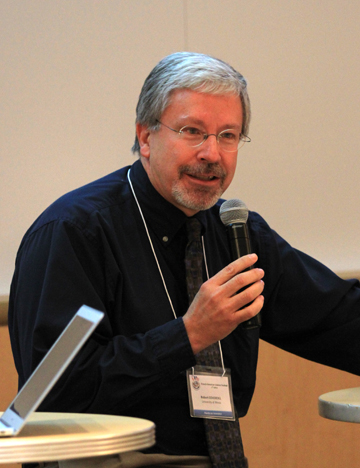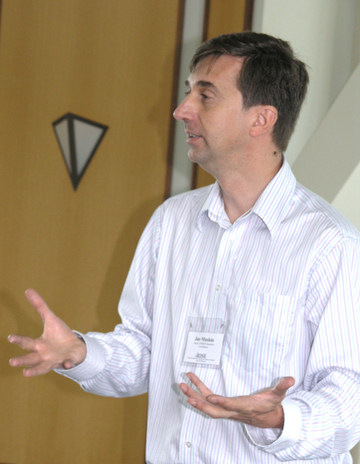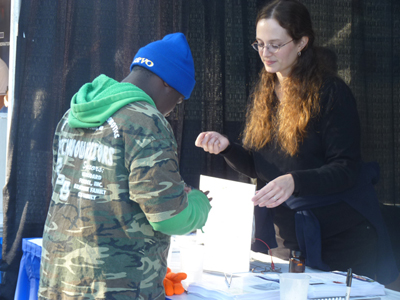Illinois STEM Educators Participate in French-American Science Festival
November 1, 2012

Bob Coverdill, I-STEM Associate Director, sharing during panel discussion on STEM education at the French-American Science Festival. Photo courtesy Joe Muskin.
On October 29–30, 2012, several representatives from the University of Illinois at Urbana-Champaign participated in the second annual French-American Science Festival held at Northwestern University in Chicago. This year's two-day festival drew upon French and U.S. expertise to address topics on the theme "Sustainable Development." The Festival was funded by the French Consulate in Chicago and organized by Adèle Martial of the French Consulate's Office for Science and Technology.
Approximately 40 people attended the panel discussion workshop, including I-STEM associate Director Bob Coverdill, who presented on STEM education outreach tools at Illinois. In addition, Nano-CEMMS education coordinators Joe Muskin and Carrie Kouadio presented on nanotechnology as part of the event's hands-on exhibits provided for elementary through high school students.
Part of the opening ceremony was a satellite feed from Lyons, France about a project between two schools, one in France and one in the U.S. The two teams received different puzzle pieces of a "Rosetta Stone" tablet inscribed with an imaginary language and went through a cultural activity to discover the translation of their pieces; the participating schools then shared their part of the project with each other via satellite, which taught students the importance of intercultural communication and global issues.
The "International Film Project: Water and Waste, Sustainable Management for All" involved high school students from three countries: France, India, and the U.S. Students from each country worked on a project about a water/waste issue in their own country, then made a video of their part in the project. A composite film made from the student videos was aired at the opening ceremony of the workshop.
Regarding the water/waste project, Coverdill commented, "Each of them had a different flavor or concern that they had to address. The kids in Milwaukee had issues with pollutants coming down the river going into Lake Michigan. The ones in India, of course, had different issues there. So it's kind of interesting that although we all have water, and we all think we know what our water issues are, they're the same but they're different. Each one has got its own issues. So that was kind of a neat collaboration."
One of the highlights of the Festival was scientific journalist Jamy Gourmaud (the French equivalent of Bill Nye, the Science Guy) who is a famous celebrity in France. The French students, and even some from the U.S., were excited about his presence and wanted to be photographed with him.
The workshop portion of the festival addressed three questions:
- How can we develop international projects in science education and outreach that treat global issues with intercultural approaches?
- How do we identify the actors and finance programs to accomplish such projects?
- What tools and programming can be used at the international scale for such projects, and how can these be shared?
Coverdill, who in his talk addressed question #3, shared about I-STEM and its role in promoting STEM education. He then shared the following four types of outreach categories, the targeted groups, and some of the specific activities used at Illinois and how these might be tailored for use internationally:
- Illinois' partnerships with k-12 schools via after-school science clubs and field trips to campus labs.
- I-STEM's High School Summer Research Experience, which gives high schoolers authentic research experiences in campus labs.
- Partnerships with national competitions, such as FIRST Robotics and Science Olympiad;
- K-12 teacher professional development through projects such as ICLCS and EnLiST.
"The idea that I was trying to convey," said Coverdill, "was that any of these things can be scaled internationally in the sense that all you need are partner institutions. If you have a university, a college, and schools or kids nearby that could benefit from this, that's all you need. You've got the main components right there. It's just a matter of putting the pieces together to make it happen."
According to Coverdill, there was a great deal of interest in his talk, and some of the questions he fielded afterwards during the question and answer session were, " Well, how do you pay for this?" as well as other questions about program logistics. Since most teachers in France are restricted in the kinds of things they can do outside of school, the notion that teachers could volunteer their time in an after-school program seemed foreign to them. To the question, "Who pays for the University's role in this?" he responded, "Well, that's a good point. I guess it's just paid by the University or the State, and that's seen as part of our outreach or our mission to provide this to the communities."
Another component of the festival was hands-on booths addressing a variety of science topics. On both days, local school groups took part in the activities, with CPS schools bringing groups on Monday, while on Tuesday, students from French-speaking schools attended the event. About 100 students participated from the French-speaking K–12 school, Lyceé Français de Chicago. This school, which follows the French national curriculum, is attended primarily by children of parents who work in the French Embassy in Chicago.
Offered a variety of hands-on science exhibits, students could wander around the event and participate in activities that looked interesting. Offering truly hands-on activities, the Nano-CEMMS booths were two of the most interesting because they gave students the opportunity to make something while they learned about nanotechnology. While Joe Muskin did an exhibit on 3D printing where students were given the opportunity to make a Lego, Carrie Kouadio did one where the youngsters mixed chemicals to make a vial of gold nanoparticles.

Joe Muskin, Nano-CEMMS eudcation coordinator
Muskin and Kouadio reported that although a large number of students experienced their exhibits, because they have done these kinds of events so often, they have a routine figured out and can move groups of youngsters through quickly, like an assembly line. For example, the 3D printing project takes about fifteen minutes; four kids at a time can make a Lego, and it takes the group about 10 minutes to do the printing; that group then moves on down the line, where they spend five minutes to clean and wrap up, while a new group begins. The gold nanoparticle project takes about five minutes for students to mix their chemicals, then put the vial in a hot water bath for another five. Then, like in a cooking show, she has some finished products made up ahead for the kids to take home and says, "Well, if you waited five minutes, it would look like this." Then she goes on to explain why the mixture looks red, and shares some applications of gold nanoparticles in cancer research.
Muskin reports that in the past in the 3D Printing demo, he's tried to do the "cooking show" thing, and supplied finished products for participants to take home. However, the kids always want to take home the one they actually made, and are willing to wait the extra 5–10 minutes to get it. He says, "It is interesting, because I've tried in past events to do the 'cooking show' with the 3-D printing, but people actually want their Lego. Gold, it's just a liquid, which is cool, but they don't feel as much ownership. But with the Lego, they actually made that Lego. They want that Lego."
Kouadio added that "In some cases, the students do want to wait for the one they made. I'll say, "If you don't mind, I've made some up ahead,' and they'll say, 'No, actually, I think I'd like to wait,' so they'll stand there, and they'll wait through another cycle of students so they can get their own. And they watch it!"
The Nano-CEMMS duo reports that the kids were very receptive, and afterwards the two received an email from the coordinators of the event saying that their hands-on presentation was one of the highlights.

Carrie Kouadio, Nano-CEMMS eudcation coordinator, working with a student. Photo courtesy Carrie Kouadio.
Regarding the popularity of the Nano-CEMMS exhibits, Muskin reported that "Students would actually pull over other students, 'Oh, this is the table that you've got to do this at!' So we didn't advertise. Other students would pull their friends over and tell them to do that. That happened several times."
Added Kouadio: "I think our exhibits were very popular, and are very popular in general, because students get to do something very hands on, very engaging, they get to learn about something that they've never done before, probably, the 3D printing and making gold nanoparticles. Also they get to take something home. So at the 3D printing, they actually get to take home the little object, and they can describe the process to their family and friends. And then with the gold nanoparticles, they actually get to take a vial home and explain how they made it, and what's inside, and what are the possible applications. So I think the combination of the two makes the exhibit really fun for the kids."
Story and photographs by Elizabeth Innes, Communications Specialist, I-STEM Education Initiative
More: I-STEM Initiatives, Nano-CEMMS,
2012













.jpg)
















